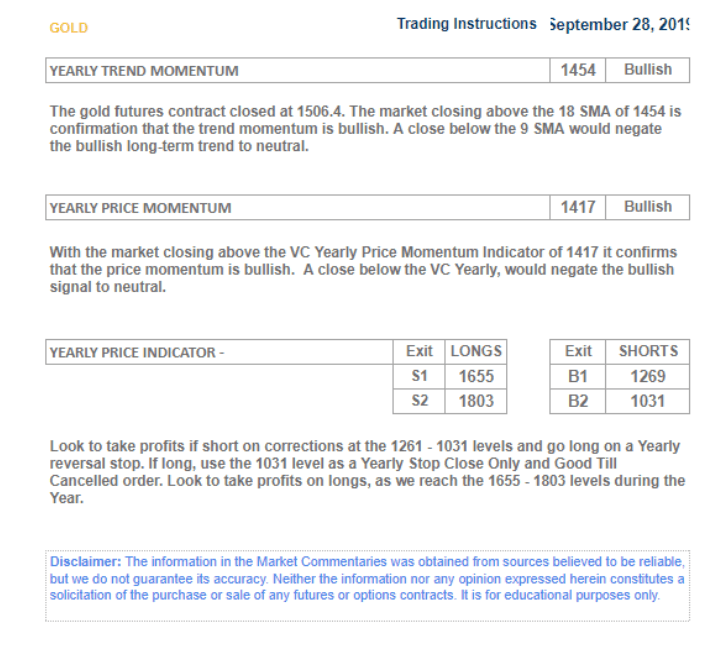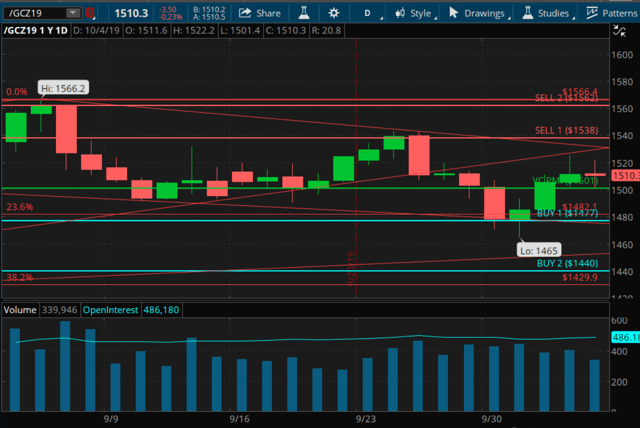Gold: Prepare For The $1,800 Handle
The fact that the market closed at $1513, below the weekly trend momentum of $1517, means that we are coming into the week bearish.
This has activated the extreme below the mean level target of $1501.
Since the market closed above the average price of $1501, it activates the targets above the mean of $1538 to $1562.
If gold closes below the mean of $1501, it will activate a bearish trend momentum and the targets below the mean of Buy 1 (B1) of $1477 to Buy 2 (B2) of $1440.
Since the market closed above $1417, which was identified as the yearly average price for 2020, it activated targets of $1655 to $1803 for the period from September 28, 2019 to September 28, 2020.
For gold, the proprietary Variable Changing Price Momentum Indicator (VC PMI) weekly indicators appear to be validating the expected correction into the levels of demand that were anticipated in our September 23, 2019 report. The market came down to make a low at $1465 on October 1, which activated the weekly buy signals, it then reverted back up to the mean of $1519, which was expected as of Friday, October 4th.
This action has activated a bullish trend momentum as we come into this week. It also confirmed a great deal of data that was expected to offer a validation of demand for gold at these levels. The market tested the extreme levels below the mean on the weekly levels at around $1482 to $1464 area.
The price came down into what appears to be the lower level of the trend lines of support of a down or bearish flag, which is a very bullish pattern. It indicates that after testing that low level of trend line support, the market has activated a buy trigger point and reverted back up and is testing the upper end of that trend line resistance at $1527.
Next Week
The fact that the market closed at $1513, below the weekly trend momentum of $1517, means that we are coming into the week with a bearish sentiment. This has activated the extreme below the mean level target of $1501. Since the market closed above the average price of $1501, it activates the targets above the mean of $1538 to $1562. For short term to intermediate traders, if you are long the market, these are targets at which to take some money off the table. Prices between $1538 and $1562 have a 90% to 95% probability of a reversion occurring back to the mean of $1501.
If gold closes below the mean of $1501, it will activate a bearish trend momentum and the targets below the mean of Buy 1 (B1) of $1477 to Buy 2 (B2) of $1440.
If the gold price comes down below $1501, it would negate this bullish trend momentum that we appear to be moving into. If the market breaks above the upper level of $1562 (S2) on the weekly data, it would indicate that a major breakout has occurred and it would activate a higher fractal in price.
"Resistance at $1562 would become a support level and we would expect much, much higher price levels," Equity Management Academy CEO Patrick MontesDeOca said.
Based on our annual report, which we published in Seeking Alpha just a few weeks ago, with the market closing on September 27 at $1506.40, it activated a bullish trend momentum for the rest of the annual period into 2020. Since the market closed above $1417, which was identified as the yearly average price for 2020, it activated targets of $1655 to $1803 for the period from September 28, 2019 to September 28, 2020.

The VC PMI Automated Algorithm
We use the proprietary Variable Changing Price Momentum Indicator (VC PMI) to analyze the precious metals markets and several indices. The primary driver of the VC PMI is the principle of reversion to the mean ("Mean Reversion Models of Financial Markets," "The Power of Mean Reversion in Factor-Based Investing"), which is combined with a range of analytical tools, including fundamental logic, wave counts, Fibonacci ratios, Gann principles, supply and demand levels, pivot points, moving averages, and momentum indicators. The science of Vedic mathematics is used to combine these elements into a comprehensive, accurate, and highly predictive trading system.
Mean reversion trading seeks to capitalize on extreme changes in the price of a particular security or commodity, based on the assumption that it will revert to its previous state. This theory can be applied to both buying and selling, as it allows a trader to profit on unexpected upswings and buy low when an abnormal low occurs. By identifying the average price (the mean) or price equilibrium based on yesterday's supply and demand factors, we can extrapolate the extreme above this average price and the extreme below it. When prices trade at these extreme levels, it's between 90% (Sell 1 or Buy 1 level) and 95% (Sell 2 or Buy 2 level) probable that prices will revert to the mean by the end of the trading session. I use this system to analyze the gold and silver markets.
Strengths And Weaknesses
The main strength of the VC PMI is the ability to identify a specific structure which price level traders can execute with a high degree of accuracy. The program is flexible enough to adjust to market volatility and alerts you when such changes take place, so one can adjust strategies accordingly. Such changes include when the market breaks out of a consolidation phase or a trend accelerates. Such volatility usually happens when the market has produced a signal at the S2 or B2 level and the market closes above or below these extreme levels.
The day trading program then confirms that a higher fractal in price has been identified and the market will move significantly higher, although the same principle applies if the market falls significantly. The price closing above the S2 level indicates that the buying demand is greater than the supply. This means that the market has found support for the next price fractal. Conversely, the price closing below the B2 level indicates that the selling pressure has met demand greater than supply at the extreme below the mean, and prices should revert back to the mean.
The basic concept of the VC PMI is that the program trades the extremes of supply and demand based on the average price daily, weekly, and monthly.
The strongest relationship we find in the algorithm is when the daily price is harmonically in alignment with the weekly and monthly indicators. We call this "harmonic timing." Such an indication produces the highest probability (90%) that the price will revert from these levels to its daily, weekly, or monthly average.
To learn more about how the VC PMI works and receive weekly reports on the E-mini, gold and silver, check out our Marketplace service, Mean Reversion Trading.
Disclosure: I am/we are long NUGT. I wrote this article myself, and it expresses my own opinions. I am not receiving compensation for it (other than from Seeking Alpha). I have no business relationship with any company whose stock is mentioned in this article.
Follow Equity Management Academy and get email alerts